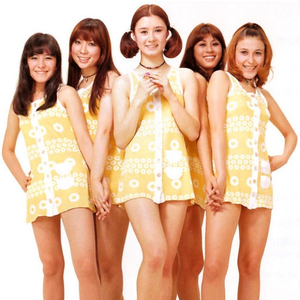m (→Members) |
mNo edit summary Tags: Mobile edit Mobile web edit |
||
| (18 intermediate revisions by the same user not shown) | |||
| Line 1: | Line 1: | ||
<youtube>Qfe-Cj3y_is</youtube> | |||
[[File:Goldenhalf-300x300.jpg |thumb|frameless|right|300px|Golden Hafu]] | [[File:Goldenhalf-300x300.jpg |thumb|frameless|right|300px|Golden Hafu]] | ||
''' | '''Golden Half''' (ゴールデンハーフ) was an all-half Japanese creation of Watanabe Productions in September 1970. Their first appearances were to sing and go-go dance on the Fuji TV show BEAT POP. They often sang western pop songs in Japanese and disbanded officially in 1974. The band appeared in the nightclub scenes in Yasuharu Hasebe’s [[Stray Cat Rock: Sex Hunter (Movie) |Stray Cat Rock: Sex Hunter]] where they performed their hit song [[Kiiroi Sakuranbo (Single)]] (“Yellow Cherry”). | ||
“Golden Half” was recruited as a mascot girls by Nippon Television’s “Drifters Daisakusen”, and they formed in the summer of 1969. At the start of the program, in the fall of the same year, in addition to Yumi, Eva and Maria, there were two other girls, Margaret and Tami. There was also Miki-san, to there were 6 girls total. The program was talking about Katakoto’s Japanese contest and sex appeal. | “Golden Half” was recruited as a mascot girls by Nippon Television’s “Drifters Daisakusen”, and they formed in the summer of 1969. At the start of the program, in the fall of the same year, in addition to Yumi, Eva and Maria, there were two other girls, Margaret and Tami. There was also Miki-san, to there were 6 girls total. The program was talking about Katakoto’s Japanese contest and sex appeal. | ||
| Line 9: | Line 9: | ||
During their career they almost exclusively covered western songs. This is attributed to the influence of Koji Kusano, director of Toshiba Records, who created the cover pop boom in guiding Saeko Hirota and Kyu Sakamoto, as well. | During their career they almost exclusively covered western songs. This is attributed to the influence of Koji Kusano, director of Toshiba Records, who created the cover pop boom in guiding Saeko Hirota and Kyu Sakamoto, as well. | ||
== | ===Final Line-Up=== | ||
* [[ | * [[Eva Marie | Eva]] (エバ・マリア・バスケス) | ||
* [[ | * [[Maria Mori | Maria]] (マリア・エリザベス) | ||
* [[Luna Takamura| | * [[Luna Takamura | Luna]] (高村ルナ) | ||
After the first version of Golden Half disbanded, a second version was launched, also by Watanabe Productions, called [[Golden Half Special]]. | ===Former Members=== | ||
* [[Eri Ishiyama | Eri]] (石山エリー) (Left late 1970) | |||
* [[Yumi Kobayashi | Yumi]] (小林ユミ) (Left late 1972) | |||
==Discography== | |||
===Albums=== | |||
* [1971.05.05] [[Golden Half Desu (Album) | Golden Half Desu]] (ゴールデンハーフでーす) | |||
* [1972.xx.xx] [[Golden Half 2 (Album) | Golden Half 2]] (ゴールデン・ハーフ2) | |||
* [1972.xx.xx] [[Adam to Eve (Album) | Adam to Eve (Album]] (アダムとイヴ) | |||
===Singles=== | |||
* [1970.08.05] [[Kiiroi Sakuranbo (Single) | Kiiroi Sakuranbo]] (黄色いサクランボ) | |||
* [1970.12.21] [[Que Sera Sera (Single) | Que Sera Sera]] (ケセラセラ) | |||
* [1971.05.05] [[Banana Boat (Single) | Banana Boat]](バナナボート) | |||
* [1971.09.25] [[Mambo Bacan (Single) | Mambo Bacan]] (マンボ・バカン) | |||
* [1971.12.01] [[Chotto Matte Kudasai (Single) | Chotto Matte Kudasai]](チョット・マッテ・クダサイ) | |||
* [1972.05.25] [[Taiyou no Kanata (Single) | Taiyou no Kanata]] (太陽の彼方) | |||
* [1972.10.05] [[24,000kai no Kiss (Single) | 24,000kai no Kiss]] (24,000回のキッス) | |||
* [1973.02.20] [[Locomotion (Single) | Locomotion]] (ロコモーション) | |||
* [1973.08.05] [[Adam to Eve (Single) | Adam to Eve]] (アダムとイヴ) | |||
* [1974.01.20] [[Melon no Kimochi (Single) | Melon no Kimochi]] (メロンの気持) | |||
After the first version of Golden Half disbanded, a second version was launched, also by Watanabe Productions, called [[:Category: Golden Half Special | Golden Half Special]]. | |||
==Links== | |||
* [https://www.discogs.com/artist/1184766-Golden-Half LPs on Discogs] | |||
* [https://jpop.fandom.com/wiki/Golden_Half J-Pop Fandom] | |||
* [https://en.wikipedia.org/wiki/Golden_Half Wikipedia] | |||
__NOTOC__ | |||
[[Category:Hāfu]] | [[Category:Hāfu]] | ||
Latest revision as of 22:07, 23 April 2024

Golden Half (ゴールデンハーフ) was an all-half Japanese creation of Watanabe Productions in September 1970. Their first appearances were to sing and go-go dance on the Fuji TV show BEAT POP. They often sang western pop songs in Japanese and disbanded officially in 1974. The band appeared in the nightclub scenes in Yasuharu Hasebe’s Stray Cat Rock: Sex Hunter where they performed their hit song Kiiroi Sakuranbo (Single) (“Yellow Cherry”).
“Golden Half” was recruited as a mascot girls by Nippon Television’s “Drifters Daisakusen”, and they formed in the summer of 1969. At the start of the program, in the fall of the same year, in addition to Yumi, Eva and Maria, there were two other girls, Margaret and Tami. There was also Miki-san, to there were 6 girls total. The program was talking about Katakoto’s Japanese contest and sex appeal.
During their career they almost exclusively covered western songs. This is attributed to the influence of Koji Kusano, director of Toshiba Records, who created the cover pop boom in guiding Saeko Hirota and Kyu Sakamoto, as well.
Final Line-Up[edit | edit source]
Former Members[edit | edit source]
Discography[edit | edit source]
Albums[edit | edit source]
- [1971.05.05] Golden Half Desu (ゴールデンハーフでーす)
- [1972.xx.xx] Golden Half 2 (ゴールデン・ハーフ2)
- [1972.xx.xx] Adam to Eve (Album (アダムとイヴ)
Singles[edit | edit source]
- [1970.08.05] Kiiroi Sakuranbo (黄色いサクランボ)
- [1970.12.21] Que Sera Sera (ケセラセラ)
- [1971.05.05] Banana Boat(バナナボート)
- [1971.09.25] Mambo Bacan (マンボ・バカン)
- [1971.12.01] Chotto Matte Kudasai(チョット・マッテ・クダサイ)
- [1972.05.25] Taiyou no Kanata (太陽の彼方)
- [1972.10.05] 24,000kai no Kiss (24,000回のキッス)
- [1973.02.20] Locomotion (ロコモーション)
- [1973.08.05] Adam to Eve (アダムとイヴ)
- [1974.01.20] Melon no Kimochi (メロンの気持)
After the first version of Golden Half disbanded, a second version was launched, also by Watanabe Productions, called Golden Half Special.
Links[edit | edit source]
Pages in category "Golden Half"
The following 26 pages are in this category, out of 26 total.